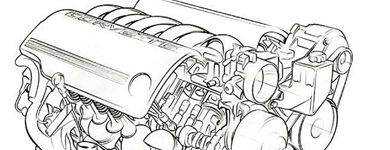
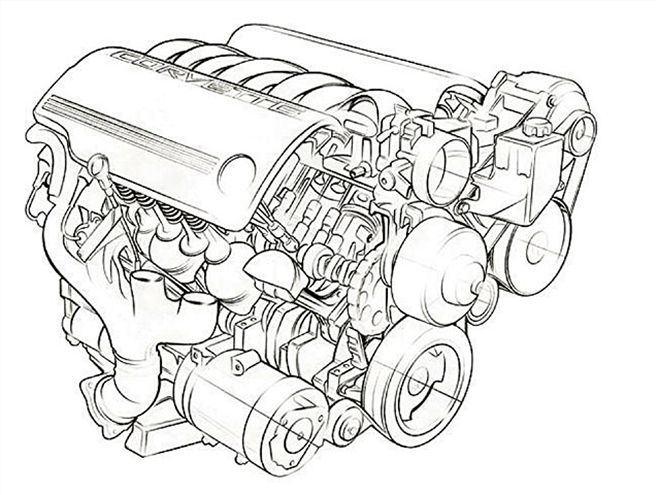 The all-aluminum LS1 was a completely new design and shared virtually nothing with earlier small-blocks.
The all-aluminum LS1 was a completely new design and shared virtually nothing with earlier small-blocks.
While our hobby is certainly steeped in tradition, technology has always played more of a role than is often recognized. Although the Flathead Ford is archaic by today's standards, it was cutting edge in 1932, and it didn't take long for enthusiasts to forsake their four-bangers for the revolutionary V-8. Then, when the new crop of OHV engines began to appear in '49, lots of Flatheads were given the heave-ho in favor of the more sophisticated contemporary powerplants. And when the 265 Chevy came on the scene in '55, it was a brave new world for hot rodders. But since the small-block Chevy first appeared, there have certainly been some advancements in engine technology, two of the most notable being General Motors' Gen III and IV series of engines, but for some reason, it's taken rodders longer to embrace them.
The first engine in the Gen III series was the LS1, which featured a bore of 3.897 inches and a stroke of 3.662 inches, resulting in a displacement of 345.69 ci; however, Chevrolet called it a 350, or a 5.7L engine. Based on an aluminum block that weighed a scant 107 lbs, thanks to the deep skirt design and six-bolt main caps, it was every bit as rigid as its 160lb cast-iron predecessor. Also found inside the block were cast-iron liners, a new, shorter nodular iron crankshaft, and powdered metal rods. While the curmudgeons among us scoff at the thought of connecting rods being made in a manner reminiscent of baking a cake, the truth is, these are the strongest rods ever to find their way inside a production GM engine.
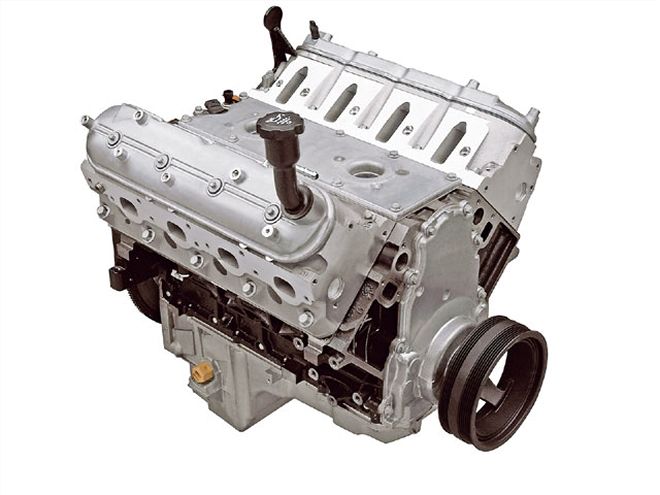 A hopped-up version of the aluminum-head/cast-iron block 5.3 LS is available from GM Performance under PN 19165628.
A hopped-up version of the aluminum-head/cast-iron block 5.3 LS is available from GM Performance under PN 19165628.
The LS1 architecture is considerably different to those familiar with the traditional small-block Chevy, which means just about every street rodder on the planet. Some of the most obvious differences are up top. Cast from 356 aluminum and heat-treated to T6 specs, the new heads have a long list of advantages over previous designs. Upon close inspection, one of the most obvious is that all the intake ports are all identical, as are the exhausts, which simply means that all cylinders breathe equally well. Less obvious differences in the new heads are the valve angles. It's generally agreed that the shallower the valve angles the better. The LS1 valves are at a 15-degree angle, considerably less than the earlier small-block's 23 degrees. But one of the LS head's most important attributes is the location of the fuel injectors. As these heads were designed for fuel injection rather than retrofit with it, the injector's fuel streams are aimed directly at the back of the intake valves.
Like most contemporary engines, the LS1 uses roller lifters as well as investment cast roller rockers. But one of the pieces that makes old-timers do a double take is the "plastic" intake manifold. Frankly, the common lament that those manifolds won't be around in 75 years like a Flathead Ford's makes us want to point out that neither will we. The fact is, making the manifold from composite material allows for the curved runner configuration, plus it's light and cost effective. Another unique feature found on the manifold is the fly-by-wire throttle body. The LSI was the first GM car to use a computer-controlled throttle (light-duty diesel trucks began using them in '95).
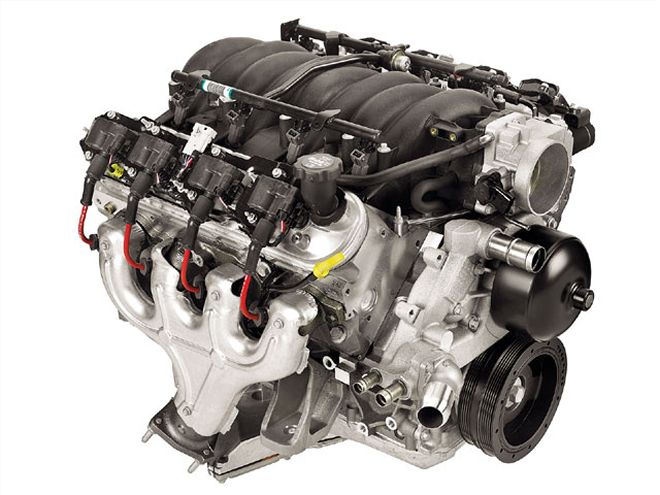 GM Performance Parts offers this complete LS1 engine assembly (PN 17801267).
GM Performance Parts offers this complete LS1 engine assembly (PN 17801267).
Of all the features of the LS1 that are out of the ordinary, the most obvious are the rocker cover-mounted coil assemblies. Each cylinder has its own coil and coil driver assembly with a short secondary wire connecting to each spark plug. The reasons given for moving the coils to the covers were the shorter plug wires lost less energy so more was delivered to the plug as well, as reduced radio frequency interference with on-board computers. A less noticeable feature is the change in firing order; no longer using the familiar 1-8-4-3-6-5-7-2 sequence, new engines fire 1-8-7-2-6-5-4-3.
With all that is unique on the LS1, one of the pieces that almost escapes notice is the pan-but there's more to it than meets the eye. There have been a half-dozen or more cast-aluminum pans used on theses engines; the Corvette, or batwing pan, is a two-piece and has two wings to the sides, and the Camaro and Firebird pans have a shallow rear sump. But no matter what the shape is, in all cases the pan becomes a part of the engine's structure when screwed in place and contributes to the block's rigidity. Another unique feature is these pans also provide a mount for the oil filter.
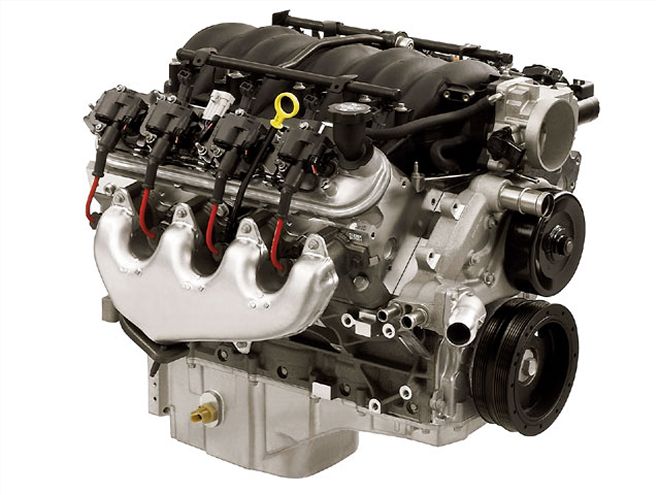 If you're looking for lots of grunt, the 5.7L LS6 makes 405 hp and 400 lb-ft of torque thanks to a higher lift cam and increased compression.
If you're looking for lots of grunt, the 5.7L LS6 makes 405 hp and 400 lb-ft of torque thanks to a higher lift cam and increased compression.
Family Tree
General Motors' new engines can be broken down into two series: Generation III and Generation IV. They share the same features and attributes in most respects.
Gen III blocks were made from cast iron in 4.8L/5.3 and 6.0L sizes (used primarily in trucks) and aluminum for 5.3L, 5.7L, and 6.0L. While iron blocks are heavier, they can easily be bored oversize during a rebuild; the aluminum blocks shouldn't be bored more than .010-inch according to GM.
As we said, there are various versions of the Gen III, but the following are most sought-after:
LS1 The 5.7L LSI was the first in the Gen III series. The engine was used in the '97 Corvette C5 and was later found in the Camaro, Firebird, and GTO. Horsepower varied from 305 to 350 depending on the application. A cast-iron version of this engine appeared in trucks in 1999.
LS6 Debuting in the C5 Z06 Corvette in 2001, this engine was an enhanced version of the LS1. The block was improved, the intake manifold modified, the cam was more aggressive, and compression was increased. While the displacement remained the same, the LS6 produced 385 hp when introduced, and it was cranking out 405 ponies by 2002.
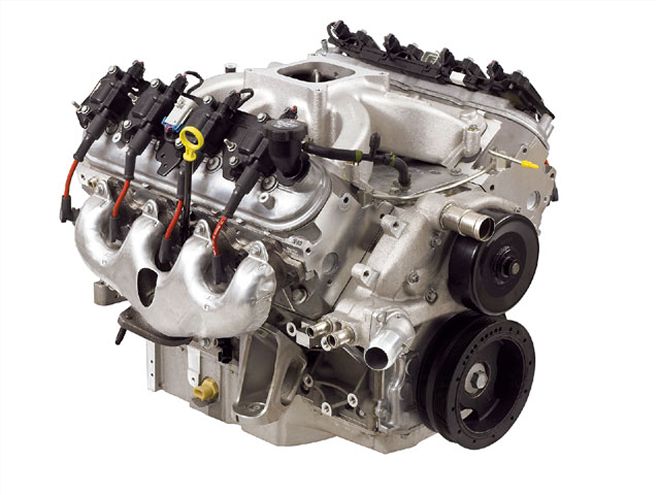 Want an LS family engine without the complication of fuel injection? The LS 364/440 (PN 17802134) is based on the LS2 and features a four-barrel intake manifold.
Want an LS family engine without the complication of fuel injection? The LS 364/440 (PN 17802134) is based on the LS2 and features a four-barrel intake manifold.
While these engines were also found in the Cadillac CTS V-series, some may remember the '70s when the original LS6 was a 454ci big-block.
Gen IV These engines were introduced in 2005 and were designed to accept GM's "displacement on demand," or DOD technology. A new lifter oil manifold was included, the cam sprocket was redesigned, a higher-volume oil pump was used, and the oil galleys were modified. For our purposes, the benefit is these blocks will accept a larger bore.
LS2 Gen IV engines introduced the big-bore versions of the LS series. The 6.0L LS2 was the new base engine for the Corvette beginning in 2005. With a 4-inch bore and a 3.62 stroke displacement, it comes out to 364 ci. Compression was 10.9:1 and it was rated at 400 horses with 400 lb-ft of torque.
In addition to Corvettes, these engines were also found in Cadillac CTS-Vs, Chevrolet SSRs, and the TrailBlazer SS.
LS3 Introduced as the new base engine for the 2008 Vette, the LS3 uses a modified LS2 block. A bigger 4.06-inch bore results in 6.2L, or 376 ci. High-flow heads, a bigger cam, an improved intake manifold, and larger injectors result in 430 hp with 424 lb-ft of torque.
LS7 Found in the 2006 Corvette Z06, the LS7 has a 4.125-inch bore and a 4.125-inch stroke that results in 7.0L/427 ci. Horsepower is 505 at 6,300 rpm, torque is 470 lb-ft at 4,800 rpm, and the redline is at 7,000 rpm. Inside, the aluminum block is some tough stuff-the crankshaft and main bearing caps are forged steel, connecting rods are forged titanium, and the pistons are hypereutectic. The LS7 is the only Gen IV engine to feature dry-sump lubrication.
LSX GM Performance Parts recently introduced the LSX, an all-new cast-iron racing block based on the LS7 engine. Designed with input from legendary drag racer Warren Johnson, it offers displacements ranging from 364 to 511 ci.
LS9 This new, mystery motor is rumored to be everything from the powerplant for the new Corvette Stingray and/or Camaro to a truck engine. Speculations persist that the engine will be supercharged and pump out 600-plus horsepower.
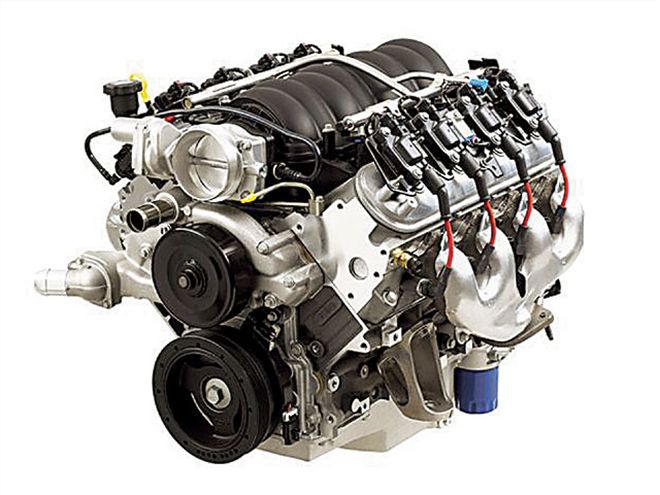 Cataloged as PN 19156261, the 6.0L LS2 produces 400 hp. Cylinder heads are high-flow pieces used previously on Corvette LS6 engines.
Cataloged as PN 19156261, the 6.0L LS2 produces 400 hp. Cylinder heads are high-flow pieces used previously on Corvette LS6 engines.
What It Takes To Join The New Generation
Installing computer-controlled engines in a street rod has become just as easy as any other engine swap. Look no further than our advertisers index at the back of the magazine or the list below (for LS-related components) to find everything you need, including complete engines, computers, wiring harnesses, throttle bodies, headers, and all the other little doodads necessary. However, there is one little oddity that you should be aware of if you're contemplating a Gen III or IV engine installation: the positions of the cooling systems inlet and outlets. They stick straight out and may require some clever plumbing so as not to use up valuable under-hood space in an early car.
With everything these new-generation engines have to offer, we'll be seeing more of them in street rods. After all, new technology really is a tradition.